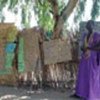Gambians break out of poverty by selling forest products, UN agricultural agency says

"Before the start of the project, villagers had not explored the market potential of handicrafts made of Rhun palm leaves, because they did not have the practical skills or market knowledge. Now they are selling products, such as chairs, tables, lampshades, baskets and beds, made of these leaves," FAO community forestry expert Sophie Grouwels said.
In a pilot area of 26 villages suffering from dire poverty, communities which used to sell a truckload of fuelwood for about $50 before the Norwegian-funded project was introduced are now selling the same amount of wood at around $700, after having organized themselves into a producer federation, FAO said.
Gambian forests were deteriorating at an alarming rate years ago, partly because the state-controlled forest management ignored the local population. In the 1990s, the Gambian Government introduced community forestry in an attempt to improve the management, but the communities still did not have many incentives to conserve the forests until the programme was introduced, it said.
"Given the success of this project, FAO hopes its methodology will be applied in other parts of the Gambia and other countries," Ms. Grouwels said.
